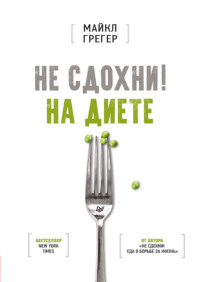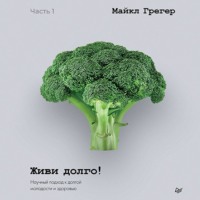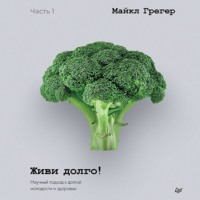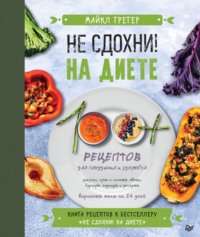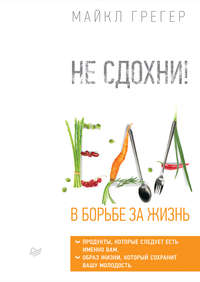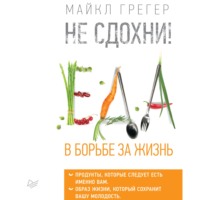
Полная версия
Живи долго! Научный подход к долгой молодости и здоровью
3557
Alwis US, Delanghe J, Dossche L, et al. Could evening dietary protein intake play a role in nocturnal polyuria? J Clin Med. 2020;9(8):E2532. https://pubmed.ncbi.nlm.nih.gov/32764521/
3558
Vidlar A, Student V, Vostalova J, et al. Cranberry fruit powder (Flowens™) improves lower urinary tract symptoms in men: a double-blind, randomized, placebo-controlled study. World J Urol. 2016;34(3):419–24. https://pubmed.ncbi.nlm.nih.gov/26049866/
3559
An YJ, Lee JY, Kim Y, Jun W, Lee YH. Cranberry powder attenuates benign prostatic hyperplasia in rats. J Med Food. 2020;23(12):1296–302. https://pubmed.ncbi.nlm.nih.gov/33136465/
3560
Vidlar A, Vostalova J, Ulrichova J, et al. The effectiveness of dried cranberries (Vaccinium macrocarpon) in men with lower urinary tract symptoms. Br J Nutr. 2010;104(8):1181–9. https://pubmed.ncbi.nlm.nih.gov/20804630/
3561
Vidlar A, Student V, Vostalova J, et al. Cranberry fruit powder (Flowens™) improves lower urinary tract symptoms in men: a double-blind, randomized, placebo-controlled study. World J Urol. 2016;34(3):419–24. https://pubmed.ncbi.nlm.nih.gov/26049866/
3562
Ledda A, Belcaro G, Dugall M, et al. Supplementation with high titer cranberry extract (Anthocran®) for the prevention of recurrent urinary tract infections in elderly men suffering from moderate prostatic hyperplasia: a pilot study. Eur Rev Med Pharmacol Sci. 2016;20(24):5205–9. https://pubmed.ncbi.nlm.nih.gov/28051247/
3563
Spettel S, Chughtai B, Feustel P, Kaufman A, Levin RM, De E. A prospective randomized double-blind trial of grape juice antioxidants in men with lower urinary tract symptoms. Neurourol Urodyn. 2013;32(3):261–5. https://pubmed.ncbi.nlm.nih.gov/22907790/
3564
Edinger MS, Koff WJ. Effect of the consumption of tomato paste on plasma prostate – specific antigen levels in patients with benign prostate hyperplasia. Braz J Med Biol Res. 2006;39(8):1115–9. https://pubmed.ncbi.nlm.nih.gov/16906286/
3565
Durak lker, Yilmaz E, Devrim E, Perk H, Kaçmaz M. Consumption of aqueous garlic extract leads to significant improvement in patients with benign prostate hyperplasia and prostate cancer. Nutr Res. 2003;23(2):199–204. https://www.sciencedirect.com/science/article/abs/pii/S0271531702004955?via%3Dihub
3566
Jani B, Rajkumar C. Ageing and vascular ageing. Postgrad Med J. 2006;82(968):357–62. https://pubmed.ncbi.nlm.nih.gov/16754702/
3567
Mosca L, Ferris A, Fabunmi R, Robertson RM, American Heart Association. Tracking women’s awareness of heart disease: an American Heart Association national study. Circulation. 2004;109(5):573–9. https://pubmed.ncbi.nlm.nih.gov/14761901/
3568
Xu J. Mortality among centenarians in the United States, 2000–2014. NCHS Data Brief. 2016;(233):1–8. https://pubmed.ncbi.nlm.nih.gov/26828422/
3569
Cushman M, Shay CM, Howard VJ, et al. Ten-year differences in women’s awareness related to coronary heart disease: results of the 2019 American Heart Association national survey: a special report from the American Heart Association. Circulation. 2021;143(7):e239–48. https://pubmed.ncbi.nlm.nih.gov/32954796/
3570
Tao J, Qiu Y. All disease stems from vessels. Aging Med (Milton). 2020;3(4):224–5. https://pubmed.ncbi.nlm.nih.gov/33392426/
3571
Jin K. A microcirculatory theory of aging. Aging Dis. 2019;10(3):676–83. https://pubmed.ncbi.nlm.nih.gov/31165010/
3572
Möbius-Winkler S, Linke A, Adams V, Schuler G, Erbs S. How to improve endothelial repair mechanisms: the lifestyle approach. Expert Rev Cardiovasc Ther. 2010;8(4):573–80. https://pubmed.ncbi.nlm.nih.gov/20397830/
3573
Sharma S, Pandey NN, Sinha M, et al. Randomized, double-blind, placebo-controlled trial to evaluate safety and therapeutic efficacy of angiogenesis induced by intraarterial autologous bone marrow-derived stem cells in patients with severe peripheral arterial disease. J Vasc Interv Radiol. 2021;32(2):157–63. https://pubmed.ncbi.nlm.nih.gov/33248918/
3574
Altabas V, Altabas K, Kirigin L. Endothelial progenitor cells (EPCs) in ageing and age-related diseases: how currently available treatment modalities affect EPC biology, atherosclerosis, and cardiovascular outcomes. Mech Ageing Dev. 2016;159:49–62. https://pubmed.ncbi.nlm.nih.gov/26919825/
3575
Hoetzer GL, Van Guilder GP, Irmiger HM, Keith RS, Stauffer BL, DeSouza CA. Aging, exercise, and endothelial progenitor cell clonogenic and migratory capacity in men. J Appl Physiol (1985). 2007;102(3):847–52. https://pubmed.ncbi.nlm.nih.gov/17158243/
3576
Wang M, Monticone RE, McGraw KR. Proinflammation, profibrosis, and arterial aging. Aging Med (Milton). 2020;3(3):159–68. https://pubmed.ncbi.nlm.nih.gov/33103036/
3577
Weech M, Altowaijri H, Mayneris-Perxachs J, et al. Replacement of dietary saturated fat with unsaturated fats increases numbers of circulating endothelial progenitor cells and decreases numbers of microparticles: findings from the randomized, controlled Dietary Intervention and VAScular function (DIVAS) study. Am J Clin Nutr. 2018;107(6):876–82. https://pubmed.ncbi.nlm.nih.gov/29741564/
3578
Shi Q, Hubbard GB, Kushwaha RS, et al. Endothelial senescence after high-cholesterol, high-fat diet challenge in baboons. Am J Physiol Heart Circ Physiol. 2007;292(6):H2913–20. https://pubmed.ncbi.nlm.nih.gov/17277030/
3579
Jeong HS, Kim S, Hong SJ, et al. Black raspberry extract increased circulating endothelial progenitor cells and improved arterial stiffness in patients with metabolic syndrome: a randomized controlled trial. J Med Food. 2016;19(4):346–52. https://pubmed.ncbi.nlm.nih.gov/26891216/
3580
Choi EY, Lee H, Woo JS, et al. Effect of onion peel extract on endothelial function and endothelial progenitor cells in overweight and obese individuals. Nutrition. 2015;31(9):1131–5. https://pubmed.ncbi.nlm.nih.gov/26233871/
3581
Kim W, Jeong MH, Cho SH, et al. Effect of green tea consumption on endothelial function and circulating endothelial progenitor cells in chronic smokers. Circ J. 2006;70(8):1052–7. https://pubmed.ncbi.nlm.nih.gov/16864941/
3582
Keith M, Kuliszewski MA, Liao C, et al. A modified portfolio diet complements medical management to reduce cardiovascular risk factors in diabetic patients with coronary artery disease. Clin Nutr. 2015;34(3):541–8. https://pubmed.ncbi.nlm.nih.gov/25023926/
3583
Steinberg D, Blumenthal S, Carleton RA, et al. Lowering blood cholesterol to prevent heart disease: NIH Consensus Development Conference statement. Nutr Rev. 1985;43(9):283–91. https://pubmed.ncbi.nlm.nih.gov/4058807/
3584
Ference BA, Ginsberg HN, Graham I, et al. Low-density lipoproteins cause atherosclerotic cardiovascular disease. 1. Evidence from genetic, epidemiologic, and clinical studies. A consensus statement from the European Atherosclerosis Society Consensus Panel. Eur Heart J. 2017;38(32):2459–72. https://pubmed.ncbi.nlm.nih.gov/28444290/
3585
Roberts WC. It’s the cholesterol, stupid! Am J Cardiol. 2010;106(9):1364–6. https://pubmed.ncbi.nlm.nih.gov/21029840/
3586
Roberts WC. William Clifford Roberts, MD curriculum vitae. http://www.iscvdp.org/docs/WCRoberts-CV.pdf. Accessed May 13, 2022.;http://www.iscvdp.org/storage/app/media/william-clifford-roberts.pdf
3587
Roberts WC. Quantitative extent of atherosclerotic plaque in the major epicardial coronary arteries in patients with fatal coronary heart disease, in coronary endarterectomy specimens, in aorta – coronary saphenous venous conduits, and means to prevent the plaques: a review after studying the coronary arteries for 50 years. Am J Cardiol. 2018;121(11):1413–35. https://pubmed.ncbi.nlm.nih.gov/29753395/
3588
Ference BA, Ginsberg HN, Graham I, et al. Low-density lipoproteins cause atherosclerotic cardiovascular disease. 1. Evidence from genetic, epidemiologic, and clinical studies. A consensus statement from the European Atherosclerosis Society Consensus Panel. Eur Heart J. 2017;38(32):2459–72. https://pubmed.ncbi.nlm.nih.gov/28444290/
3589
Fernández-Friera L, Fuster V, López-Melgar B, et al. Normal LDL – cholesterol levels are associated with subclinical atherosclerosis in the absence of risk factors. J Am Coll Cardiol. 2017;70(24):2979–91. https://pubmed.ncbi.nlm.nih.gov/29241485/
3590
Nambi V, Bhatt DL. Primary prevention of atherosclerosis: time to take a selfie? J Am Coll Cardiol. 2017;70(24):2992–4. https://pubmed.ncbi.nlm.nih.gov/29241486/
3591
Hochholzer W, Giugliano RP. Lipid lowering goals: back to nature? Ther Adv Cardiovasc Dis. 2010;4(3):185–91. https://pubmed.ncbi.nlm.nih.gov/20400493/
3592
Fernández-Friera L, Fuster V, López-Melgar B, et al. Normal LDL – cholesterol levels are associated with subclinical atherosclerosis in the absence of risk factors. J Am Coll Cardiol. 2017;70(24):2979–91. https://pubmed.ncbi.nlm.nih.gov/29241485/
3593
Gitin A, Pfeffer MA, Hennekens CH. Editorial commentary: the lower the LDL the better but how and how much? Trends Cardiovasc Med. 2018;28(5):355–6. https://pubmed.ncbi.nlm.nih.gov/29428160/
3594
Law MR, Wald NJ. Risk factor thresholds: their existence under scrutiny. BMJ. 2002;324(7353):1570–6. https://pubmed.ncbi.nlm.nih.gov/12089098/
3595
Hochholzer W, Giugliano RP. Lipid lowering goals: back to nature? Ther Adv Cardiovasc Dis. 2010;4(3):185–91. https://pubmed.ncbi.nlm.nih.gov/20400493/
3596
O’Keefe JH, Cordain L, Harris WH, Moe RM, Vogel R. Optimal low-density lipoprotein is 50 to 70 mg/dL: lower is better and physiologically normal. J Am Coll Cardiol. 2004;43(11):2142–6. https://pubmed.ncbi.nlm.nih.gov/15172426/
3597
Anderson JW, Konz EC, Jenkins DJ. Health advantages and disadvantages of weight-reducing diets: a computer analysis and critical review. J Am Coll Nutr. 2000;19(5):578–90. https://pubmed.ncbi.nlm.nih.gov/11022871/
3598
Hochholzer W, Giugliano RP. Lipid lowering goals: back to nature? Ther Adv Cardiovasc Dis. 2010;4(3):185–91. https://pubmed.ncbi.nlm.nih.gov/20400493/
3599
Law MR, Wald NJ. Risk factor thresholds: their existence under scrutiny. BMJ. 2002;324(7353):1570–6. https://pubmed.ncbi.nlm.nih.gov/12089098/
3600
Roberts WC. Quantitative extent of atherosclerotic plaque in the major epicardial coronary arteries in patients with fatal coronary heart disease, in coronary endarterectomy specimens, in aorta – coronary saphenous venous conduits, and means to prevent the plaques: a review after studying the coronary arteries for 50 years. Am J Cardiol. 2018;121(11):1413–35. https://pubmed.ncbi.nlm.nih.gov/29753395/
3601
Packard CJ. LDL cholesterol: How low to go? Trends Cardiovasc Med. 2018;28(5):348–54. https://pubmed.ncbi.nlm.nih.gov/29336946/
3602
Packard CJ. LDL cholesterol: How low to go? Trends Cardiovasc Med. 2018;28(5):348–54. https://pubmed.ncbi.nlm.nih.gov/29336946/
3603
Nambi V, Bhatt DL. Primary prevention of atherosclerosis: time to take a selfie? J Am Coll Cardiol. 2017;70(24):2992–4. https://pubmed.ncbi.nlm.nih.gov/29241486/
3604
Hong KN, Fuster V, Rosenson RS, Rosendorff C, Bhatt DL. How low to go with glucose, cholesterol, and blood pressure in primary prevention of CVD. J Am Coll Cardiol. 2017;70(17):2171–85. https://pubmed.ncbi.nlm.nih.gov/29050566/
3605
Baigent C, Blackwell L, Emberson J, et al. Efficacy and safety of more intensive lowering of LDL cholesterol: a meta-analysis of data from 170,000 participants in 26 randomised trials. Lancet. 2010;376(9753):1670–81. https://pubmed.ncbi.nlm.nih.gov/21067804/
3606
Guber K, Pemmasani G, Malik A, Aronow WS, Yandrapalli S, Frishman WH. Statins and higher diabetes mellitus risk: incidence, proposed mechanisms, and clinical implications. Cardiol Rev. 2021;29(6):314–22. https://pubmed.ncbi.nlm.nih.gov/32947479/
3607
Hong KN, Fuster V, Rosenson RS, Rosendorff C, Bhatt DL. How low to go with glucose, cholesterol, and blood pressure in primary prevention of CVD. J Am Coll Cardiol. 2017;70(17):2171–85. https://pubmed.ncbi.nlm.nih.gov/29050566/
3608
Glenn AJ, Li J, Lo K, et al. The Portfolio Diet and incident type 2 diabetes: findings from the Women’s Health Initiative prospective cohort study. Diabetes Care. 2023;46(1):28–37. https://pubmed.ncbi.nlm.nih.gov/36162007/
3609
Sliding scale for LDL: how low should you go? The target for the safest amount of “bad” cholesterol continues to drift downward. Harv Heart Lett. 2011;21(12):5. https://pubmed.ncbi.nlm.nih.gov/21991609/
3610
How low should your cholesterol go? Even lower may be better. For those at highest risk, very low cholesterol levels may help prevent a second heart attack or stroke. Health News. 2004;10(10):6. https://pubmed.ncbi.nlm.nih.gov/15584114/
3611
De Biase SG, Fernandes SFC, Gianini RJ, Duarte JLG. Vegetarian diet and cholesterol and triglycerides levels. Arq Bras Cardiol. 2007;88(1):35–9. https://pubmed.ncbi.nlm.nih.gov/17364116/
3612
Kahleova H, Levin S, Barnard ND. Vegetarian dietary patterns and cardiovascular disease. Prog Cardiovasc Dis. 2018;61(1):54–61. https://pubmed.ncbi.nlm.nih.gov/29800598/
3613
The US Burden of Disease Collaborators, Mokdad AH, Ballestros K, et al. The state of US health, 1990–2016: burden of diseases, injuries, and risk factors among US states. JAMA. 2018;319(14):1444–72. https://pubmed.ncbi.nlm.nih.gov/29634829/
3614
Huang Z, Xu A, Cheung BMY. The potential role of fibroblast growth factor 21 in lipid metabolism and hypertension. Curr Hypertens Rep. 2017;19(4):28. https://pubmed.ncbi.nlm.nih.gov/28337713/
3615
Lewington S, Clarke R, Qizilbash N, et al. Age-specific relevance of usual blood pressure to vascular mortality: a meta-analysis of individual data for one million adults in 61 prospective studies [published correction appears in Lancet. 2003;361(9362):1060]. Lancet. 2002;360(9349):1903–13. https://pubmed.ncbi.nlm.nih.gov/12493255/
3616
Kramer H, Cooper R. Pros and cons of intensive systolic blood pressure lowering. Curr Hypertens Rep. 2018;20(2):16. https://pubmed.ncbi.nlm.nih.gov/29511979/
3617
Kjeldsen SE, Os I, Westheim A. Could adverse events offset the benefit of intensive blood pressure lowering treatment in the Systolic Blood Pressure Intervention Trial? J Hypertens. 2019;37(5):902–4. https://pubmed.ncbi.nlm.nih.gov/30920495/
3618
Fuster V. No such thing as ideal blood pressure: a case for personalized medicine. J Am Coll Cardiol. 2016;67(25):3014–5. https://pubmed.ncbi.nlm.nih.gov/27339499/
3619
Goldhamer A, Lisle D, Parpia B, Anderson SV, Campbell TC. Medically supervised water-only fasting in the treatment of hypertension. J Manipulative Physiol Ther. 2001;24(5):335–9. https://pubmed.ncbi.nlm.nih.gov/11416824/
3620
McDougall J, Litzau K, Haver E, Saunders V, Spiller GA. Rapid reduction of serum cholesterol and blood pressure by a twelve-day, very low fat, strictly vegetarian diet. J Am Coll Nutr. 1995;14(5):491–6. https://pubmed.ncbi.nlm.nih.gov/8522729/
3621
Brown MS, Goldstein JL. Biomedicine. Lowering LDL – not only how low, but how long? Science. 2006;311(5768):1721–3. https://pubmed.ncbi.nlm.nih.gov/16556829/
3622
McGill HC, McMahan CA. Determinants of atherosclerosis in the young. Am J Cardiol. 1998;82(10B):30T-6T. https://pubmed.ncbi.nlm.nih.gov/9860371/
3623
Strong JP, Malcom GT, McMahan CA, et al. Prevalence and extent of atherosclerosis in adolescents and young adults: implications for prevention from the Pathobiological Determinants of Atherosclerosis in Youth Study. JAMA. 1999;281(8):727–35. https://pubmed.ncbi.nlm.nih.gov/10052443/
3624
Steinberg D, Glass CK, Witztum JL. Evidence mandating earlier and more aggressive treatment of hypercholesterolemia. Circulation. 2008;118(6):672–7. https://pubmed.ncbi.nlm.nih.gov/18678783/
3625
Myerburg RJ, Junttila MJ. 2012. Sudden cardiac death caused by coronary heart disease. Circulation. 28;125(8):1043–52. https://pubmed.ncbi.nlm.nih.gov/22371442/
3626
Brown MS, Goldstein JL. Biomedicine. Lowering LDL – not only how low, but how long? Science. 2006;311(5768):1721–3. https://pubmed.ncbi.nlm.nih.gov/16556829/
3627
Steinberg D, Glass CK, Witztum JL. Evidence mandating earlier and more aggressive treatment of hypercholesterolemia. Circulation. 2008;118(6):672–7. https://pubmed.ncbi.nlm.nih.gov/18678783/
3628
Cohen J, Pertsemlidis A, Kotowski IK, Graham R, Garcia CK, Hobbs HH. Low LDL cholesterol in individuals of African descent resulting from frequent nonsense mutations in PCSK9. Nat Genet. 2005;37(2):161–5. https://pubmed.ncbi.nlm.nih.gov/15654334/
3629
Cohen JC, Boerwinkle E, Mosley TH, Hobbs HH. Sequence variations in PCSK9, low LDL, and protection against coronary heart disease. N Engl J Med. 2006;354(12):1264–72. https://pubmed.ncbi.nlm.nih.gov/16554528/
3630
Robinson JG, Gidding SS. Curing atherosclerosis should be the next major cardiovascular prevention goal. J Am Coll Cardiol. 2014;63(25):2779–85. https://pubmed.ncbi.nlm.nih.gov/24814489/
3631
Brown MS, Goldstein JL. Biomedicine. Lowering LDL – not only how low, but how long? Science. 2006;311(5768):1721–3. https://pubmed.ncbi.nlm.nih.gov/16556829/
3632
Wang N, Fulcher J, Abeysuriya N, et al. Intensive LDL cholesterol – lowering treatment beyond current recommendations for the prevention of major vascular events: a systematic review and meta-analysis of randomised trials including 327¿037 participants. Lancet Diabetes Endocrinol. 2020;8(1):36–49. https://pubmed.ncbi.nlm.nih.gov/31862150/
3633
Shapiro MD, Bhatt DL. “Cholesterol-years” for ASCVD risk prediction and treatment. J Am Coll Cardiol. 2020;76(13):1517–20. https://pubmed.ncbi.nlm.nih.gov/32972527/
3634
Kaplan H, Thompson RC, Trumble BC, et al. Coronary atherosclerosis in indigenous South American Tsimane: a cross-sectional cohort study. Lancet. 2017;389(10080):1730–9. https://pubmed.ncbi.nlm.nih.gov/28320601/
3635
Penson PE, Pirro M, Banach M. LDL–C: lower is better for longer – even at low risk. BMC Med. 2020;18(1):320. https://pubmed.ncbi.nlm.nih.gov/33032586/
3636
Ference BA, Ginsberg HN, Graham I, et al. Low-density lipoproteins cause atherosclerotic cardiovascular disease. 1. Evidence from genetic, epidemiologic, and clinical studies. A consensus statement from the European Atherosclerosis Society Consensus Panel. Eur Heart J. 2017;38(32):2459–72. https://pubmed.ncbi.nlm.nih.gov/28444290/
3637
Brown MS, Goldstein JL. Biomedicine. Lowering LDL – not only how low, but how long? Science. 2006;311(5768):1721–3. https://pubmed.ncbi.nlm.nih.gov/16556829/
3638
Kahleova H, Levin S, Barnard ND. Vegetarian dietary patterns and cardiovascular disease. Prog Cardiovasc Dis. 2018;61(1):54–61. https://pubmed.ncbi.nlm.nih.gov/29800598/
3639
O’Keefe JH, Cordain L, Harris WH, Moe RM, Vogel R. Optimal low-density lipoprotein is 50 to 70 mg/dL: lower is better and physiologically normal. J Am Coll Cardiol. 2004;43(11):2142–6. https://pubmed.ncbi.nlm.nih.gov/15172426/
3640
Roberts WC. Cholesterol is the cause of atherosclerosis. Am J Cardiol. 2017;120(9):1696. https://pubmed.ncbi.nlm.nih.gov/28847597/
3641
Kataoka Y, Hammadah M, Puri R, et al. Plaque microstructures in patients with coronary artery disease who achieved very low low-density lipoprotein cholesterol levels. Atherosclerosis. 2015;242(2):490–5. https://pubmed.ncbi.nlm.nih.gov/26298740/
3642
Diamond DM, Ravnskov U. How statistical deception created the appearance that statins are safe and effective in primary and secondary prevention of cardiovascular disease. Expert Rev Clin Pharmacol. 2015;8(2):201–10. https://pubmed.ncbi.nlm.nih.gov/25672965/
3643
Trewby PN, Reddy AV, Trewby CS, Ashton VJ, Brennan G, Inglis J. Are preventive drugs preventive enough? A study of patients’ expectation of benefit from preventive drugs. Clin Med (Lond). 2002;2(6):527–33. https://pubmed.ncbi.nlm.nih.gov/12528966/
3644
Salami JA, Warraich H, Valero-Elizondo J, et al. National trends in statin use and expenditures in the US adult population from 2002 to 2013: insights from the Medical Expenditure Panel Survey. JAMA Cardiol. 2017;2(1):56–65. https://pubmed.ncbi.nlm.nih.gov/29358195/
3645
Diprose W, Verster F. The preventive-pill paradox: how shared decision making could increase cardiovascular morbidity and mortality. Circulation. 2016;134(21):1599–600. https://pubmed.ncbi.nlm.nih.gov/27881503/
3646
Ziaeian B, Fonarow GC. Statins and the prevention of heart disease. JAMA Cardiol. 2017;2(4):464. https://pubmed.ncbi.nlm.nih.gov/28122083/
3647
ASCVD Risk Estimator Plus. American College of Cardiology. https://tools.acc.org/ASCVD-Risk-Estimator/. Accessed April 3, 2022.; https://tools.acc.org/ASCVD-Risk-Estimator/
3648
Framingham Risk Score. Medscape. https://reference.medscape.com/calculator/framingham-cardiovascular-disease-risk. Accessed April 3, 2022.; https://reference.medscape.com/calculator/252/framingham-risk-score-2008
3649
Reynolds Risk Score. https://www.reynoldsriskscore.org. Accessed April 3, 2022.; https://www.reynoldsriskscore.org/
3650
Lloyd-Jones DM, Braun LT, Ndumele CE, et al. Use of risk assessment tools to guide decision-making in the primary prevention of atherosclerotic cardiovascular disease: a special report from the American Heart Association and American College of Cardiology. J Am Coll Cardiol. 2019;73(24):3153–67. https://pubmed.ncbi.nlm.nih.gov/30586766/
3651
Lloyd-Jones DM, Braun LT, Ndumele CE, et al. Use of risk assessment tools to guide decision-making in the primary prevention of atherosclerotic cardiovascular disease: a special report from the American Heart Association and American College of Cardiology. J Am Coll Cardiol. 2019;73(24):3153–67. https://pubmed.ncbi.nlm.nih.gov/30586766/







